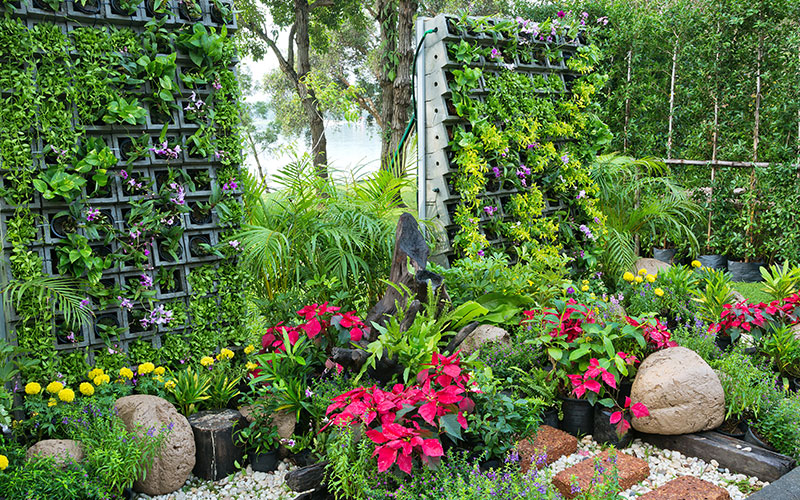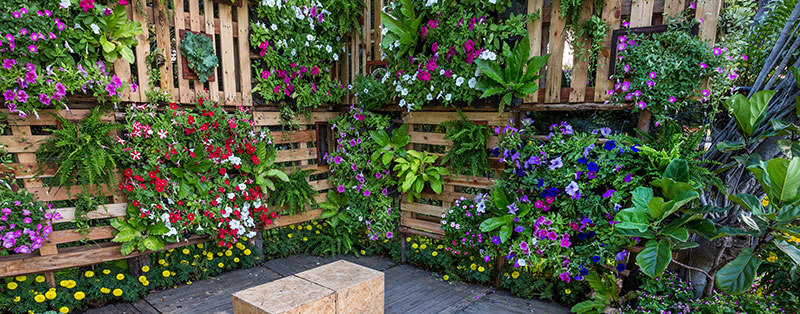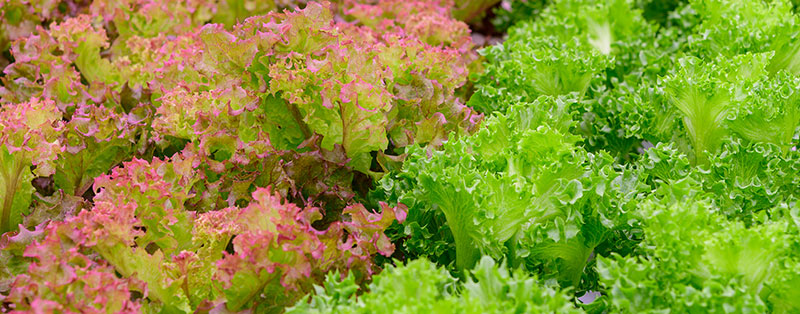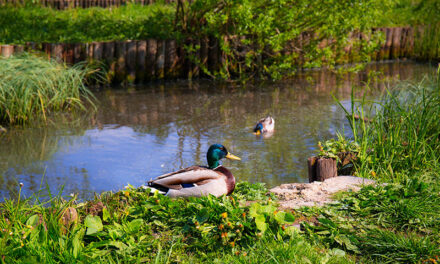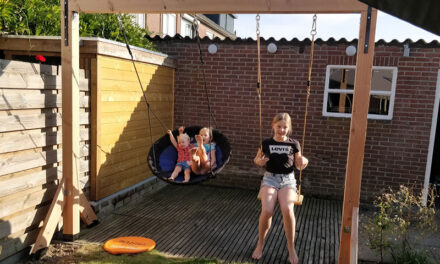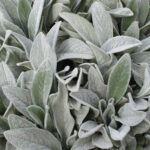Vertical gardens are fancy and extraordinary. They come in various sizes and shapes. A vertical garden indoor can be like a living wall painting and an outdoor vertical garden is easily created with smart systems or racks. Or you can get creative with materials you love to create a work of art for indoor or outdoor use. The advantage of a planted wall is that it has an insulating effect, and it protects your home against sun and weather influences. You also contribute to air purification and a better ecosystem.
Outdoors you can think big, such as huge buildings that are completely covered with plants. In contrast to a vertical garden of a few pots on your fence or a cozy series of herb pots in a rack on your balcony. You can adjust it exactly to the space you have. Because I assume that you do not have an entire building to cover, I will limit myself in this article to the possibilities in the backyard, on your balcony, or in the house.
Vertical garden outdoor
If you are looking for ideas you will come across a lot of possibilities. The most simple form of a vertical garden outdoor is a flower box you can hang on your fence or balcony. There are hanging pots available you just need to hook over your fence and you’re done. Next to this you can also use pallets or complete irrigation systems.
4 practical tips for your vertical garden
- Make sure that the fence, wall, balcony, or wherever you want to create your garden is sturdy enough to attach your vertical garden to. It is better to hang heavier systems or bins on a stone wall than a light fence.
- Decide in advance which plants you want to put in your upright garden and what conditions they prefer, for example, do not put sun-loving plants in the shade and plants that do not tolerate wind well in a sheltered place.
- If you don’t have a choice of where to place the vertical garden, make sure to adapt the plants to the conditions in that location.
- Group plants that grow at about the same rate to prevent one overgrowing the other. The plant that is overgrown will get less space and possibly even die.
The vertical garden
Vertical gardening is gardening in an enclosed space, such as a pot or container. It is important that you use potting soil around the container, bag, or pot that you hang. Just like with regular pots, the soil you use in a vertical garden dries out faster, so it is important that you use potting soil. Potting soil retains the water and keeps the pot moist.
If you stack plants on top of each other, make sure the plants that need the least amount of water are planted at the top. Because water runs from top to bottom, the plants at the top will run out of water faster than the ones at the bottom. Because you generally have more plants per amount of potting soil in a vertical garden, it is important to water regularly. You can also install an irrigation system to help you.
Create a vertical garden outdoors
There are very creative ways to design your vertical garden. For example, there are all kinds of charming options available in the store or via the internet. There are ready-made systems, where you can assemble a wall as large as you want. For example, you can put 3 plants in each part. These parts can be attached next to and above each other. You could even make a whole fence with this. But you can also place 2 or 3 on top of each other in your outdoor kitchen or on your balcony. This already contains a drainage system and these bins are available in different colors.
There is also a kind of bag for sale, where you hang the plants. These are not expensive at all and are easy to purchase online, you can immediately start planting.
Vertical garden DIY
There are many, many examples you can create by yourself. Just google ‘vertical garden DIY and you will a lot of tutorials, examples, and more. Below I describe some easy and awesome vertical garden ideas.
- Attach a rack to the wall where you want a vertical garden. Next, hang a number of pots, balcony boxes, or hanging pots on this rack with hooks.
- Hang a number of gutters in your preferred length, fill them with potting soil and make a drainage hole under which you hang another gutter with rope or a chain.
- Place or hang a pallet, fill it with felt or jute, so that the potting soil cannot get away, but the water can. Add the potting soil and plant your pretty plants in the pallet.
- Do you know those shoe organizers made of felt? Hang one of those on the wall and fill it with plants.
- Make a cool system with plastic bottles, also environmentally conscious! Hold the bottle vertically and cut out a rectangular part. If you attach a few bottles one above the other with rope, you only have to put potting soil in it, and you can easily grow your herbs in the kitchen.
Vertical garden rack
You can buy a ready-made rack to hang your pots on. It is also easy to make a sturdy durable rack from rebar, on which you can hang everything. This is also often used to guide climbing plants. There are many racks available at home furnishings stores at the moment, which you can easily use for your vertical garden. Another possibility is to create a system from a number of chains on which you hang pots and planters.
Vertical garden system
There are a number of systems are available for installing a vertical wall. These systems often already include a drainage system. They can be expanded and adapted to your wishes. Obviously, you still have to fill the pots with potting soil and plants. There are also companies where you can buy an all-ready vertical garden and place it in your garden. You don’t even have to plant your plants anymore! These systems are available for the facade walls. For indoors and at companies, there are also ready-made systems to brighten up your walls and provide your environment with oxygen and a good ecosystem.
Vertical garden with pallets
You can also make a vertical garden from a pallet. If desired, you can also use multiple pallets. Pallet and scaffolding wood are trendy materials for furniture design at the moment. So, next to your couch made of pallets, your vertical garden made of pallets looks perfect!
Sand the pallet to prevent splinters, and, optionally, you can then paint or stain the pallet in a nice color. Next, place the pallet on the floor and attach burlap or felt to the back and sides of the pallet. Make sure these are properly stapled. After this, you fill the pallet with potting soil. And lastly, plant the plants you want. Note; it is best to keep the pallet flat for a few weeks so that the roots of the plants adhere well. After that, you can put your pallet upright and enjoy your homemade vertical garden.
Vertical garden indoor
For indoors or in the office you have special systems that you can easily assemble and that already contain drainage. Just like outside. There are also companies that will install this for you. A simpler form for your home is to place a plant ladder, which you fill with plants. You do not have to attach this to your wall. With some wood and rope, you can also hang plants on top of each other in a very creative and cheap way. Think of the macramé way of hanging plants and hang a number of them under each other. You can also make a ‘painting’ of plants to hang on your wall. Do you want to know how? Check out our pinterest page for inspiration.
Plants for a vertical garden
Sedum and succulents are easy plants that require little water and grow well in any location. They do prefer a sunny position.
Plants for the vertical garden in the shade
Ferns, in particular Dryopteris, Asplenium, Polypodium, and Adianthum, are decorative plants and suitable for the vertical garden. You have ferns in different colors, often green, but also with a silver glow or, for example, a purple underside. Ferns combine beautifully with the foliage of the hosta, of which you also have many varieties. Hosta has all kinds of green foliage, from blue to bright to yellow-green. Even more special are the so-called combined hostas with a green leaf with a white edge or yellow edge. The smaller, low grasses are excellent for planting in a vertical garden. And there you go, you already have 3 varieties with very different leaves to put in your vertical shade garden.
Plants for the vertical garden in the sun
As mentioned sedum and succulents are easy plants that require little water and grow well in any location. They do prefer a sunny place. Low grasses can be planted in both shade and sun. Violets, Bugleherb, Cranesbill, and Coral bells are plants that are suitable for the vertical garden. The Cranesbill in particular is available in many different colors.
What about herbs, fruits, and vegetables?
Strawberry is often grown and kept in pots, so it’s perfect for a vertical garden. Herbs such as Chives, Lavender, and Mint can also be planted in a vertical herb garden. Please be aware that the plants need more moisture or choose fruits, herbs, and vegetables that can survive in a dry environment.

